With a Return On Investment(ROI) of $42 for every $1 spent, email marketing is still one of the best marketing channels for businesses today. However, constantly sending promotional emails without context will only encourage your customers to mark you as spam.
So, how do we leverage the power of email marketing automation without appearing too promotional?
The answer is triggered email marketing campaigns!
In this blog, we will explore six compelling reasons why triggered email marketing is indispensable to a successful digital marketing strategy.
What is Triggered Email Marketing?
Triggered email marketing campaigns are automated messages sent in response to users’ actions, such as signing up for a newsletter, making a purchase, or abandoning a shopping cart. Unlike standard email campaigns that operate on a set schedule, trigger emails are timely, directly responding to the user’s behavior. This ensures that the content is relevant and delivered at a moment when the user is most likely to engage with it.
Let’s say you run an online bookstore. A customer, Isha, visits your website and adds a mystery novel to her cart but doesn’t buy it. She forgets about it and closes the site.
Normally, that might be the end of the story. But with triggered email marketing, as soon as Isha leaves the site without buying the book, your smart system automatically sends her an email saying, “Hey Isha, you forgot something in your cart! Still interested in the mystery novel? Here’s a quick link to finish your purchase.”
This email is not sent because it’s Tuesday at 10 AM (like regularly scheduled emails) but because Isha did something specific (left a book in her cart). It’s timely because it catches her while she might still be thinking about the book, and it’s relevant because it’s about exactly what she was looking at. This makes Isha more likely to open the email and complete the purchase.
Now, let’s dive into understanding why trigger email marketing matters.
Bonus Read – Email Marketing : 8 Proven Ways To Improve Email Open Rate
For those who still doubt if an automated email marketing system is worth the time and money, consider these six data-backed reasons to implement a marketing automated tool.
6 Key Advantages Of Using Triggered Emails In Your Marketing Strategy
- Higher open rates and click-through rates
- Higher conversion rates
- Greater relevancy
- Faster segmenting and scheduling
- Greater customer retention
- Increased opportunities to sell, upsell and gather data
1. Higher open rates and click-through rates
According to Smart Insights, automated emails produce 71% higher open rates and 102% higher click-through rates than their non-triggered counterparts.
It’s not surprising, considering that triggered emails are effective because they’re relevant and timely. Triggered email marketing that includes automated responses based on customer behaviors capitalizes on the fact that the business has its customer’s attention and is sending an email based on his interest and timeline and not that of company’s.
What are some of the controllable factors that can impact open rates and click-throughs in triggered emails?
- Great subject lines
Businesses should tailor their email marketing strategies by crafting subject lines that grab readers’ attention. It’s not just about creating a sense of mystery, controversy, or urgency but also about hitting the sweet spot in terms of length. A recent report by Retention Science indicates subject lines consisting of 6 to 10 words now yield the highest open rates, with 8 words being the optimal length.
This shift suggests that while briefness is essential, providing enough context to captivate the recipient is equally crucial. A well-balanced subject line can effectively convey value, importance, or urgency while maintaining a concise appeal.
EXAMPLES:
“Don’t Miss Our Exclusive Weekend Sale!”
“Last Chance: Your Loyalty Reward Expires!”
“Limited Time: 50% Off All Accessories!”
“Unlock Secret Deals on Your Next Trip!”
“Hurry! Your Favorite Items Back in Stock!”
- Personalization and segmentation
Businesses can increase open rates and click-throughs by adding a personal touch with a name and/or mention of a past behavior or purchase. Segmenting should go beyond the typical demographics to include things like recency, spending history, and purchase frequency while being cautious not to overlap email content.
- Psychology
Research shows that certain tactics, such as the use of cognitive dissonance in marketing content, increase click rates. The loss aversion theory states that customers prefer avoiding losses to acquiring gains. Choxi does a good job of using loss aversion in its trigger emails by urging customers to use their $10 credit within 48 hours.

Reciprocity—the idea of feeling compelled to repay someone for doing something nice for you—also comes into play. It’s the psychology behind the free return address stickers—also known as “front-end premiums”—that animal rescue organizations send out. They’re hoping that most people would feel guilty getting something for nothing and eventually send in a donation.In triggered email marketing, businesses can use the psychology of reciprocity by giving away free white papers, webinars, promotional codes or ebooks in exchange for information.The scarcity principle also plays into triggered email marketing. When a customer browses information about a webinar but doesn’t sign up, businesses can have a triggered email warning of limited seating remaining. Or a customer who recently browsed men’s shirts might receive an email citing urgency and limited stock, like Mizzen+Main’s does here.

2. Higher conversion rates
Triggered email marketing isn’t just about staying connected with your audience; it’s a powerful tool for boosting sales. In 2022, trigger email campaigns achieved the highest average order value (AOV) among all types of email marketing campaigns. This means that when emails are sent based on specific actions or behaviors of customers, they’re more likely to grab attention and drive sales.
Why is this the case? Triggered emails are timely and relevant. Imagine receiving an email about a product you recently viewed or added to your cart. This personalized approach makes you feel understood and valued, increasing the likelihood of completing a purchase.
This translates into more clicks and meaningful engagements that lead to higher sales. It’s a win-win: customers receive timely information and offers, while businesses enjoy higher conversion rates and AOV.
Here are some more benefits of trigger email campaigns:
- Capturing lost profits
Businesses using triggered emails for things like cart abandonment reminders may find that even a small percent of triggered emails can substantially increase revenue. The conversion rate for cart abandonment can be increased with enticements—such as a discount code for 20% off.
-
-
Immediate engagement
-
Likewise, a “how-to-get-started” email—like Jet’s below—that’s triggered when a customer joins a membership club, could increase conversion rates.

-
- Guided call to action
Targeted emails can serve as a guide to customers, with businesses steering them toward the next level of engagement. Trigger emails produce the most timely calls to action possible, and catching a potential customer who is already well-qualified will almost always increase conversions.
-
- Here is a trigger email example by Lemlist, an AI-powered sales engagement platform sending a welcome email with clear, guided CTAs.Stronger lifecycle marketing
Triggered email drips can maximize lifecycle marketing—customer engagement over time—for both B2C and B2B products and services. For example, a B2B that offers on-demand software can send triggered emails based on the chosen plan, giving the subscriber more personalized content at each interaction. Appropriately matched content at each use case can increase customer satisfaction and conversion rates.
-
- More & better leads
Businesses that use email marketing automation generate twice as many leads as those who don’t.
In addition to generating more leads, businesses report that email marketing automation has helped improve the quality of leads passed to their sales teams and hence increase the revenue per sale. Specifically, 43% of marketing teams reported that automation improved the quality of leads and 28% of marketing teams said that their average deal size had increased. This is likely to do automation’s ability to help a company educate buyers and strengthen customer relations.
-
-
-
-
Faster response to leads
-
Automation also increases the speed at which the sales teams can get notification of a lead and make a call. A study published in the Harvard Business Review found that companies that contacted potential customers within an hour of receiving a query were 60 times as likely to qualify the lead as those who waited 24 hours or longer.
-
-
Cross-promotion opportunities
-
Something as simple as including a related promotion in digital receipts with automated emails may boost sales. In fact, in a study by Experian, just adding a cross-sell recommendation in shipping confirmation emails increased transaction rates by 20%. Check out how Crate & Barrel uses an order confirmation as an opportunity to recommend other products that the customer might like, and promote their other brands, CB2 and The Land of Nod.

-
-
Quick ROI
-
Focus Research reports that 75% of companies using marketing automation see a return on their investment in just 12 months.
While email marketing in general is reported to have a 4400% return on investment, automated email marketing ups the ante by not only providing a great return on investment, but also a timely one.
The key word here is investment, because according to Venture Beat Insight, even the 22% of marketing automation users who consider the technology to be “pricey,” said it’s still worth it.
It’s also interesting to note that another 10% of those surveyed cite marketing automation as being inexpensive, and 47% consider it fairly priced.
3. Greater relevancy
Triggered email marketing campaigns enable businesses to provide relevant and personalized emails to the recipients. Approximately 80% of business leaders acknowledge that consumers spend more (an average of 34% more) when their experience is personalized.
- Timing of trigger
The email is based on a user action; e.g., a real-time shipping update
- Geographic location
Proximity to a store or event; e.g., a real-time weather update for the traveler’s destination
- Demographics
Age, gender, income, race, profession, etc.; e.g., sending a Millennial an email about retirement will likely lead to an unsubscribe
- Past behavior
Previous downloads, purchases, engagement; e.g., if the customer has downloaded a white paper, businesses might suggest a webinar
- Customized customer relationship management data
e.g., a targeted email from a supplier asking for an update on their inventory when a stocked unit count goes lower than the set threshold
Here’s how Worx uses triggered emails to remind customers what they recently viewed and recommend other relevant products they might like.

It’s hard for these types of triggered emails to be perceived as irrelevant when the business is simply reminding customers what they just looked at.
4. Faster segmenting and scheduling
Triggered emails are automatically sent based on the customer’s interactions or when a user performs a specific action, like signing up for a newsletter or leaving items in a cart. For example, a customer who abandons a shopping cart receives a different email than one who completes a purchase. This automated segmentation ensures the right messages reach the right people at the right time.
Thus, email marketing automation frees up time for marketers to do other things. With a simple click or drag-and-drop, marketers can add variables to match the right offer or message to a prospect using predictive analytics that incorporate preferred variables, such as location, behavior and demographics.
Of course, increased efficiency may mean reduced staffing costs. After all, the best email automation software can allow one person to do the job of two—or more—employees.
5. Greater customer retention
In addition to being cheaper to keep existing customers than to acquire new ones, the Gartner Group points out that 80% of your future profits will come from 20% of existing customers.
That’s a pretty strong incentive to keep them happy.
Email automation tool can help businesses do that, by improving their customers’ experience through follow-ups, personalization, prompt responsiveness and nurturing.
Among other things, that could mean setting up triggered email marketing to:
- Remind customers about appointments
- Ask for feedback
- Inform customers when the subscription is about to end
- Remind customers when a credit card for automatic billing is about to expire
- Let customers know when an upgrade or out-of-stock item is available
- Offer customers anniversary reminders or special promotions on their birthday
- Remind customers when they’re due for an annual physical, biannual dental cleaning or regular oil change
In addition, businesses can set their programs to recognize an absence of behavior, which then launches an email encouraging the customer to re-engage, as Duolingo does below.

-
- Stop sending emails into the void and start building meaningful customer relationships with WebEngage!
6. Increased opportunities to sell, upsell and gather data
According to Adestra, 58% of marketers say that the biggest benefit of automation is increased opportunities to sell, upsell or gather data.
Triggered emails can be used for progressive profiling—gathering information over several different landing pages or forms. By taking caution to work from a master list to avoid asking the same question more than once per client, businesses can gather more detailed information.
Behaviors before, during and after a purchase can all serve the purpose of selling or upselling. Here are some examples:
- A potential customer clicks on a link to read a review and receives an email offering a 30-day, risk-free trial.
- A customer receives a follow-up email saying that the company hopes they are enjoying their product and reminding them that it’s almost time to order a new water filter/vacuum bag/ink cartridge.
- A customer emails the help desk with an issue and receives an email asking them to take a customer service survey, as SquareSpace did below.

Conclusion
Investing in automated email marketing can increase profits in a relatively short period of time. But it’s vital that businesses realize that implementing triggered emails isn’t enough. They need to be used regularly, properly and with a strong strategy in place and there needs to be plenty of personalization. “Automated” shouldn’t be considered a synonym for “robotic.”
Businesses can significantly enhance customer engagement by automating sending emails based on specific user behaviors. From welcoming new subscribers to re-engaging those who have abandoned their shopping carts, each triggered email serves as a targeted touchpoint, fostering a deeper connection between the brand and its customers.
The key takeaway is that triggered emails are not just about sending messages—they’re about sending the right message at the right time. For that, you need the right tools. With tools like WebEngage, you can automate email workflows for every stage of the customer lifecycle.
Ready to elevate your email marketing strategy? Book a demo to know more.
-








 Diksha Dwivedi
Diksha Dwivedi

 Kasturi Patra
Kasturi Patra








